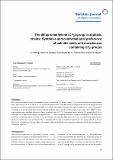Files in this item
The difluoromethylene (CF2) group in aliphatic chains : synthesis and conformational preference of palmitic acids and nonadecane containing CF2 groups
Item metadata
| dc.contributor.author | Wang, Yi | |
| dc.contributor.author | Callejo, Ricardo | |
| dc.contributor.author | Slawin, Alexandra M. Z. | |
| dc.contributor.author | O'Hagan, David | |
| dc.date.accessioned | 2014-07-09T14:31:02Z | |
| dc.date.available | 2014-07-09T14:31:02Z | |
| dc.date.issued | 2014-01-06 | |
| dc.identifier | 111957840 | |
| dc.identifier | f59f45d5-6e71-4780-a957-bec7be884e34 | |
| dc.identifier | 000329819900002 | |
| dc.identifier | 84891908587 | |
| dc.identifier | 000329819900002 | |
| dc.identifier.citation | Wang , Y , Callejo , R , Slawin , A M Z & O'Hagan , D 2014 , ' The difluoromethylene (CF 2 ) group in aliphatic chains : synthesis and conformational preference of palmitic acids and nonadecane containing CF 2 groups ' , Beilstein Journal of Organic Chemistry , vol. 10 , pp. 18-25 . https://doi.org/10.3762/bjoc.10.4 | en |
| dc.identifier.issn | 1860-5397 | |
| dc.identifier.other | ORCID: /0000-0002-9527-6418/work/56861500 | |
| dc.identifier.other | ORCID: /0000-0002-0510-5552/work/68281223 | |
| dc.identifier.uri | https://hdl.handle.net/10023/4990 | |
| dc.description | Funding: ERC Advanced Investigator Grant (D.O'H). | en |
| dc.description.abstract | The syntheses of palmitic acids and a nonadecane are reported with CF2 groups located 1,3 or 1,4 to each other along the aliphatic chain. Specifically 8,8,10,10- and 8,8,11,11-tetrafluorohexadecanoic acids (6b and 6c) are prepared as well as the singly modified analogue 8,8-difluorohexadecanoic acid (6a). Also 8,8,11,11-tetrafluorononadecane (27) is prepared as a pure hydrocarbon containing a 1,4-di-CF2 motif. The modified palmitic acids are characterized by differential scanning calorimetry (DSC) to determine melting points and phase behaviour relative to palmitic acid (62.5 degrees C). It emerges that 6c, with the CF2 groups placed 1,4- to each other, has a significantly higher melting point (89.9 degrees C) when compared to the other analogues and palmitic acid itself. It is a crystalline compound and the structure reveals an extended anti-zig-zag chain. Similarly 8,8,11,11-tetrafluorononadecane (27) adopts an extended anti-zig-zag structure. This is rationalized by dipolar relaxation between the two CF2 groups placed 1,4 to each other in the extended anti-zig-zag chain and suggests a design modification for long chain aliphatics which can introduce conformational stability. | |
| dc.format.extent | 8 | |
| dc.format.extent | 1838465 | |
| dc.format.extent | 5022618 | |
| dc.language.iso | eng | |
| dc.relation.ispartof | Beilstein Journal of Organic Chemistry | en |
| dc.subject | Difluoromethylene | en |
| dc.subject | Fatty acids | en |
| dc.subject | Fluorination | en |
| dc.subject | Organic fluorine chemistry | en |
| dc.subject | Organo-fluorine | en |
| dc.subject | Palmitic acid | en |
| dc.subject | C-F Bbond | en |
| dc.subject | Organofluorine chemistry | en |
| dc.subject | Organic-compounds | en |
| dc.subject | Flourine | en |
| dc.subject | Derivatives | en |
| dc.subject | Reagents | en |
| dc.subject | QD Chemistry | en |
| dc.subject.lcc | QD | en |
| dc.title | The difluoromethylene (CF2) group in aliphatic chains : synthesis and conformational preference of palmitic acids and nonadecane containing CF2 groups | en |
| dc.type | Journal article | en |
| dc.contributor.sponsor | EPSRC | en |
| dc.contributor.sponsor | EPSRC | en |
| dc.contributor.institution | University of St Andrews. School of Chemistry | en |
| dc.contributor.institution | University of St Andrews. EaSTCHEM | en |
| dc.contributor.institution | University of St Andrews. Biomedical Sciences Research Complex | en |
| dc.identifier.doi | 10.3762/bjoc.10.4 | |
| dc.description.status | Peer reviewed | en |
| dc.identifier.url | http://www.beilstein-journals.org/bjoc/single/articleFullText.htm?publicId=1860-5397-10-4 | en |
| dc.identifier.grantnumber | EP/H022651/1 | en |
| dc.identifier.grantnumber | EP/K022946/1 | en |
This item appears in the following Collection(s)
Items in the St Andrews Research Repository are protected by copyright, with all rights reserved, unless otherwise indicated.


